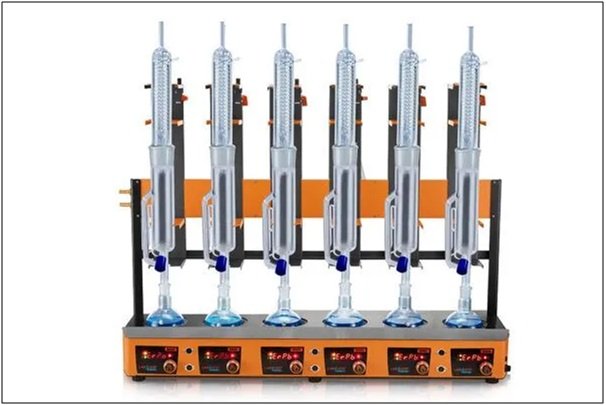A Soxhlet Extraction Apparatus is a critical piece of lab equipment used across the food and feed industry for precise extraction processes. Proper cleaning and maintenance are essential to prevent contamination, ensure accuracy, and extend the equipment’s lifespan. Neglecting routine care can lead to residue buildup, inefficient siphoning, and degradation of glassware. This guide outlines an industry-standard approach for maintaining Soxhlet systems.
Soxhlet Apparatus Components and Their Cleaning Priorities
Each part of a Soxhlet apparatus requires different handling methods to maintain functionality. They include:
| Component | Function | Cleaning Priority |
| Round-bottom flask | Holds and heats the solvent | Remove solvent residues; check for cracks |
| Extraction Chamber | Contains the sample, allows solvent percolation | Prevent the buildup of extracted material |
| Siphon Tube | Recirculates solvent back into the flask | Ensure proper drainage, prevent clogging |
| Condenser | Cools solvent vapours | Remove condensation residues |
The Soxhlet Extraction Apparatus from leading brands, such as Borosil Scientific, includes a bulb in the siphon tube to enhance siphoning efficiency and protect against blockages. Proper cleaning of this feature ensures uninterrupted solvent cycling.
Routine Cleaning Procedure
1. Disassembly & Initial Rinse
- Allow cooling before handling.
- Carefully separate all components to prevent undue stress on joints.
- Rinse with the same solvent used in the extraction to dissolve initial residues.
2. Detergent Wash
- Use a mild laboratory detergent and warm distilled water.
- Soak the extraction chamber to loosen stubborn residues.
- Scrub the round-bottom flask and siphon tube with a soft-bristle brush; never use abrasive materials.
3. Removing Stubborn Contaminants
- Organic residues: Soak in a 10% nitric acid solution.
- Lipid-based residues: Rinse with hexane or chloroform.
- Mineral deposits: Treat with 2% hydrochloric acid, followed by thorough rinsing.
4. Final Rinse & Drying
- Rinse all components 3-4 times with deionised water.
- A final rinse with acetone accelerates drying and prevents water spots.
- Dry using a glass dryer or vacuum pump to ensure complete moisture removal.
Deep Cleaning & Periodic Maintenance
Routine cleaning isn’t enough for long-term use. Every 10-15 cycles, a deep cleaning process is required. This step includes the following:
| Cleaning Step | Purpose | Frequency |
| Water test machine check | Detects invisible contaminants | Every 10–15 uses |
| Overnight acid soak | Removes micro-residues | Monthly |
| Oven drying | Ensures complete removal of moisture | after each deep cleaning |
| Joint lubrication | Prevents wear and breakage | Weekly |
Deep cleaning makes sure that the siphoning mechanism remains efficient and that no residual contaminants interfere with extraction purity.
Storage & Handling Best Practices
Proper storage of Soxhlet apparatus components reduces the risk of contamination and breakage:
- Use a dust-free cabinet or a cushioned rack.
- Store glass components separately to prevent scratches.
- Apply a minimal amount of silicone grease to ground glass joints to prevent sticking or damage.
Common Mistakes of Soxhlet Apparatuses
Some of the most common mistakes that lab technicians might make that ruin Soxhlet apparatuses, which you should avoid, include:
| Mistake | Consequence | Prevention |
| Skipping the oven drying step | Moisture trapped inside affects extraction accuracy | Dry in a low-temp oven (below 105°C) before next use |
| Leaving solvent traces | Old solvent may react or contaminate future samples | Ensure glassware is fully clean and dry |
| High-heat drying | Causes thermal stress and cracks | Use air drying or a vacuum pump |
| Improper storage | Dust and airborne particles cause contamination | Use a closed, dust-free environment |
| Using metal or rough brushes | Scratches weaken glass parts over time | Use only soft-bristle or sponge brushes |
Many failures occur due to neglecting siphon tube cleaning. A blocked tube prevents proper solvent cycling, significantly reducing extraction efficiency.
Maintaining Extraction Efficiency: Key Takeaways
Regular cleaning is very important to prevent contamination that can interfere with extraction results. Any residual solvent, detergent, or acid left inside the Soxhlet apparatus can alter sample composition, leading to inaccurate data. Make sure you give it a thorough rinse with deionised water, followed by proper drying, to minimise this risk.
Soxhlet-specific features, such as the bulb in the siphon tube, play a crucial role in maintaining consistent solvent cycling. If not cleaned properly, obstructions can form, disrupting the siphoning process and reducing extraction efficiency. Regular inspection of the siphon and vapour tubes prevents blockages and ensures optimal function.
Drying is equally important. Any residual moisture can lead to inconsistent results or introduce contaminants into the next extraction cycle. Using a moisture balance provides complete moisture removal, safeguarding the integrity of the extraction process.
Storage conditions significantly impact the longevity of the Soxhlet apparatus. Glass components should be kept in a dust-free, controlled environment with proper support to prevent mechanical stress or accidental damage.
Conclusion
A well-maintained Soxhlet Extraction Apparatus is critical for obtaining accurate, reproducible results in laboratory extractions. Routine cleaning, deep maintenance, and proper storage significantly extend the lifespan of the equipment while ensuring consistent solvent recovery and sample integrity. Attention to specific features, such as the siphon tube and vapour path, prevents operational disruptions and contamination. By incorporating these best practices, laboratory professionals can maintain the efficiency and reliability of Soxhlet extractions, supporting high-precision work in food & feed applications. Consistent care leads to better performance, lower replacement costs, and uninterrupted laboratory operations.






